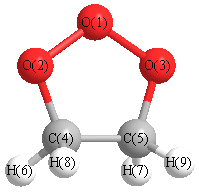Vibrational Frequencies calculated at CCD/6-31G
| Mode Number |
Symmetry |
Frequency
(cm-1) |
Scaled Frequency
(cm-1) |
IR Intensities
(km mol-1) |
Raman Act
(Å4/u) |
Dep P |
Dep U |
|---|
| 1 |
A' |
3150 |
3022 |
27.94 |
|
|
|
| 2 |
A' |
3079 |
2954 |
20.08 |
|
|
|
| 3 |
A' |
1562 |
1498 |
0.32 |
|
|
|
| 4 |
A' |
1358 |
1303 |
0.09 |
|
|
|
| 5 |
A' |
1220 |
1170 |
1.34 |
|
|
|
| 6 |
A' |
989 |
949 |
3.87 |
|
|
|
| 7 |
A' |
896 |
860 |
18.84 |
|
|
|
| 8 |
A' |
880 |
844 |
0.46 |
|
|
|
| 9 |
A' |
789 |
757 |
1.74 |
|
|
|
| 10 |
A' |
644 |
618 |
1.77 |
|
|
|
| 11 |
A' |
337 |
323 |
5.54 |
|
|
|
| 12 |
A" |
3130 |
3003 |
0.10 |
|
|
|
| 13 |
A" |
3070 |
2945 |
17.90 |
|
|
|
| 14 |
A" |
1548 |
1486 |
1.17 |
|
|
|
| 15 |
A" |
1377 |
1321 |
3.21 |
|
|
|
| 16 |
A" |
1252 |
1201 |
0.13 |
|
|
|
| 17 |
A" |
1136 |
1090 |
0.01 |
|
|
|
| 18 |
A" |
962 |
923 |
3.14 |
|
|
|
| 19 |
A" |
717 |
688 |
25.28 |
|
|
|
| 20 |
A" |
676 |
649 |
0.04 |
|
|
|
| 21 |
A" |
47 |
45 |
3.28 |
|
|
|
Unscaled Zero Point Vibrational Energy (zpe) 14407.8 cm
-1
Scaled (by 0.9595) Zero Point Vibrational Energy (zpe) 13824.3 cm
-1
See section
III.C.1 List or set vibrational scaling factors
to change the scale factors used here.
See section
III.C.2
Calculate a vibrational scaling factor for a given set of molecules
to determine the least squares best scaling factor.
